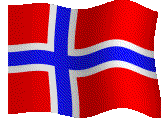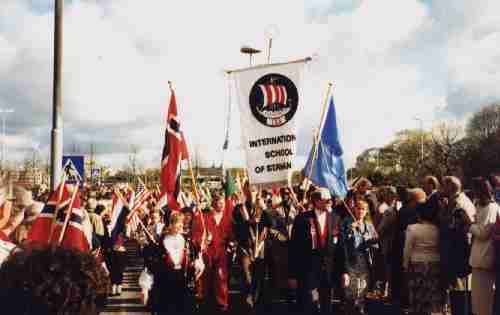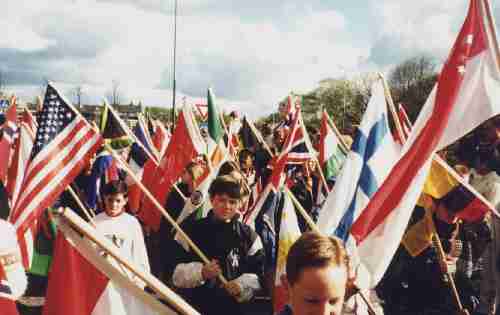


Constitution Day - May 17th.
by Michael Holmboe Meyer

After beeing under Danish rule for some 400 years Norway had her own revolution in 1814. A very peaceful revolution, consisted of calling a constituonal convention which declared that Norway is a free and indivisable kingdom.
The constitution of the Kingdom of Norway proclaimed by the Constituent Assembly at Eidsvold on the 17th of May 1814.

§ 100
"There shall be liberty of the Press. No person must be punished for any writing, whatever its contents may be, which he has caused to be printed or published, unless he wilfully and manifestely has either himself shown or incited others to disobeidence to the laws, contemt of religion or morality or the constitutional powers, or resistance to their orders, or has advanced false and dematory accusations against any other person. Everyone shall be free to speak his mind frankly on the administration of the State or on any subject whatsoever."

The Constitution day is still the most celebrated in the nation. But it is not celebrated - as independence is in other nations - with large military parades and displais of the most terrifying military parades with arms and weapons.
Norway`s birthday is celebrated with party-clothed children and adults who walk in a parade singing.
This is the Day of an independent and freedom-loving people. And children`s parades is everywhere in the country. Everywhere - even in the smallest villages: Children are singing!
Norway`s day of independence is the day for the future: It is the day for the children - Children of all ages: Young and old!
Stavanger has become international. On a sunny day you can hear five or six languages in the marketplace. Twenty years ago you could go out to eat Norwegian or Chinese food. Today it is possible to choose between restaurants specializing in French, Italian, American, Japanese, Etiopian, Turkish, Greek and Thai delicacies - oriental or continental - all in addition to Norwegian and Chinese.
Twenty years ago it was impossible to buy foreign grocery products. Today a Stavanger family is likely to be dining at home on tacos or pizza as salt lamb or cod.
Norwegians join in enthusiastic to celebrate the Indian New Year in October, Guy Fawkes Day in November, the Turkish National Day in April and the American 4th of July.
All the foreing schools march enthusiastic in the Childrens Parade on May 17th, celebrating the Norwegian Constitution Day.
Today the Norwegian who grew up learning "Oxford" English has learned to understand the Australian, Canadian or South African variety as easely as that from Houston or London.
Norwegians would like to think they are free of prejudice, but there remains a large group that would prefer keeping Norway for the Norwegians. A survey showed that 50 percent of all Norwegians would rather not have foreigners living in Norway - no matter where the foreigner comes from.
But the survey also showed it was those people who had least contact with foreigners who still had the most prejudices. Among those who deal with foreigners living in Norway there was less perjudice. That`s a healthy sign.
Norway had her constitution in 1814. Norway was the first country in the world to grant full suffrage to women, in 1913.
Being fair: One can say Norway is a pioneer in may ways. And being "fair" is one of the nicest of Norwegian characteristics and it pervades all of society.
STAVANGER HAS FOLLOWING TWIN TOWNS:

Esbjerg, Denmark.
Eskilstuna, Sweden.
Jyvaskyla, Finland.
Nedskapstadu, Iceland.
Aberdeen, Scotland.
Houston/Galveston, Texas.
Ansirabe, Madagaskar
Esteli, Nicaragua.
Netanya, Israel
 Waffle vision
Waffle vision
Poem by
Lars Chr. Sande
My waffel iron
makes waffles
with five hearts.
A delicious
golden brown
joined in a circle and
glowing warmly
like a little sun.
Waffle hearts
should symbolise
humanity on
the globe`s
five continent
on the day
 they have reached
they have reached
the goal
of solidarity.
Toghether
we haved developed
just ways
to share our resources.
The aroma of fresh
waffles ticles
the nostrils.
Freshly baked, golden
with blackberry jam.
Heart by heart.
Can there be a better
Sunday tea-time treat
in Paradise?
The 17th of May - A historical date and a day of
national celebrations
By Knut Mykland
The author of the following article, Knut Mykland, is a professor at the Institute of History in the University of Bergen.
The United States has the 4th of July as its National Day commemorating the American Declaration of Independence.
The French celebrate the 14th of July in memory of the storming of the Bastille and the downfall of l'ancien regime. The
17th of May is Norway's National Day. In the history of Norway, 17 May 1814 marks both the country's declaration of
independence and the triumph of constitutional government. In order to understand the dominant place occupied by the
celebration of the 17th of May in the national consciousness it is necessary to view it against its historical background.
In 1319 Norway was linked with Sweden in a union after over 400 years as a self-governing and independent realm. In
1380 Norway and Denmark were united under the same king, a union which eventually led to Norway's being integrated
in a Danish-Norwegian single unified state with Denmark as the realm's dominant partner and Copenhagen as the
unchallenged capital of the kingdom. It was not until 14 January 1814, the date of the Treaty of Kiel, that the
Danish-Norwegian dual monarchy was dissolved and King Fredrik IV of Denmark was forced to cede Norway to the
King of Sweden.
It is true that from the middle of the 18th century there had been a certain amount of discontent in Norway over the fact
that the country's interests were disregarded to Denmark's advantage and, above all, to the advantage of the dual
monarchy's capital, Copenhagen. There were repeated Norwegian requests that the country should have its own
university and its own national bank, but it was not until 1811 that the demand for a university was finally met. The
demand for a bank continued to be rejected out of fear that the dual monarchy could break up if Norway were to
acquire a separate and independent monetary system.
When Denmark-Norway was drawn into the whirlpool of the Napoleonic wars in 1807, Fredrik VI opted for alliance
with France and war with England. His choice was determined exclusively out of consideration to the Realm's continental
portion, Denmark and the two duchies of Schleswig and Holstein. As far as Norway was concerned the war with
England meant blockade, crisis and hunger. In this situation there were clear signs of a growing separatist movement in
Norway and increasing disenchantment with the existing regime and the union with Denmark. Some Norwegians, among
them Count Wedel Jarlsberg, went so far as to advocate Norway's separation from Denmark and the establishment of a
union with Sweden. However, this discontent never reached such proportions as to threaten the existence of the dual
monarchy. When Norway was separated from Denmark by the Treaty of Kiel on 14 January 1814, this came not as a
result of dissatisfaction in Norway, but rather as a consequence of the policies Napoleon's former marshal, Jean Baptiste
Bernadotte, had pursued after he was elected Crown Prince of Sweden in 1810 and as heir- presumptive to the Swedish
throne adopted the name Carl Johan. Norway was the reward of the victorious commander in the field, in return for his
and Sweden's support to the allies in the final reckoning with Napoleon.
From the spring of 1813 the young heir-presumptive to the Danish- Norwegian crown, Prince Christian Fredrik,
resided in Norway as "Stattholder". At the end of January, when he received news of the Peace signed at Kiel and the
cession of Norway to Sweden, he decided to prevent the realization of the cession of the Kingdom by placing himself at
the head of a Norwegian independence movement, with reunion with Denmark as his unexpressed secret hope. King
Fredrik VI of Denmark was well aware of the Prince's plan, was in sympathy with it, and himself supported the
independence movement in Norway by supplying large quantities of grain.
When Christian Fredrik incited the Norwegians to fight for their independence, he was in no doubt that he enjoyed the
support of large sectors of the population. The Norwegian independence movement received encouragement from many
different traditional sources: the attachment to the old royal house, hopes for reunion with Denmark, anti-Danish feeling,
recollections of bygone days and fear of a union with Sweden. From these vague and confused dreams, there developed
in Norway, during the winter and spring of 1814, a powerful and heady desire for independence: Norway was once
again to join the ranks of independent states as a free, self-governing realm, as she had been many centuries earlier.
There was one point on which Christian Fredrik's political plans after the Treaty of Kiel were frustrated by the desires
and hopes of the upper stratum of society. After the news of the Treaty of Kiel and the cession of the Kingdom reached
Norway, Christian Fredrik had the intention of ascending the Norwegian throne by virtue of his alleged right of
inheritance and of governing the Kingdom as the only rightful absolute monarch. However, many prominent office-holders
and other citizens nourished a strong desire for a free constitution, a desire to which the Prince would have to give way if
he were to bring his policy of independence to a successful conclusion. On 10 April 1814 the popularly elected National
Assembly met at Eidsvold Iron Works outside Christiania (Oslo) for the purpose of giving the country a constitution. As
one of the representatives described this Assembly: "Here was to be seen a selection of men from all parts of the realm,
of all ranks and dialects, men from court circles as well as landowners come together in no set order for the sacred
purpose of laying the foundations for the rebirth of the nation." Six weeks later, on 17 May 1814, the National Assembly
had completed its work on the Constitution, and on the same day closed its proceedings by electing Prince Christian
Fredrik King of Norway. The solemn proceedings ended with a short and powerful speech by the President, Georg
Sverdrup, linking the old free Norway to the Norway which was now emerging: "Thus within Norway's boundaries is
resurrected Norway's ancient seat of Kings, which was graced by Athelstans and Sverres and from which, with wisdom
and might, they ruled over Norway of old."
The fact that Christian Fredrik was able to unite the Norwegians in the struggle for independence and, in cooperation
with the National Assembly, to organize the government of the new state in the course of a few hectic weeks prior to the
17th of May was due to Carl Johan's continued involvement on the Continent with the main Swedish army. But after
Napoleon was forced to abdicate at the beginning of April, the Crown Prince of Sweden had fulfilled his obligations to
his allies and, towards the end of May 1814, he was able to return to Sweden with the Swedish army. Despite bombastic
statements from Norway, and despite the declaration "Death before slavery", after a short war Norway was forced into a
union with Sweden, the union became effective when the Storting (the Norwegian Parliament) elected Carl XIII of
Sweden as King of Norway on 4 November 1814. But the constitutional form of the Kingdom was in all main respects
such as was laid down in the Constitution of 17 May, and the union with Sweden was so loose that it could be dissolved
in 1905 without either kingdom being seriously affected as a result.
There are therefore good grounds for regarding 17 May 1814 as the pre- eminent date in Norway's history. After
centuries as a dependency Norway once again joined the ranks of free states as an independent realm, and the new union
with Sweden proved only to be an intermezzo, with no influence on the inner development of the country. From being
subjected -- at least in theory -- to a most extreme form of despotism, the country emerged with a more liberal
Constitution than any other contemporary state. While other free constitutions in Europe, drawn up during the
Revolutionary and Napoleonic eras, were rescinded and substituted by more authoritarian regimes, the Norwegian
Constitution remained standing.
As early as the 1820s people started to celebrate the 17th of May, and since then this day has been established as
Norway's National Day, Norway's Liberation Day, even though the celebrations have in the course of time changed their
character and form. The history of the 17th of May celebrations in Norway reflects in many ways the main features of the
country's history from 1814 until today.
When Carl Johan, as the victor of 1814, accepted the 17th of May Constitution as the basis for government in Norway,
within the framework of a union with Sweden, there were many reasons for this policy: hope of once again being able to
play a role in French politics, fear of a Gustavian restoration in Sweden, fear of a winter war in Norway, the desire to win
the Norwegians over to the idea of a union with Sweden through concessions and a policy of appeasement. Among these
motives, there was one which had the future in mind: the hope of later winning back what he had been obliged to give up
in 1814. It was this last motive which formed the basis for Carl Johan's policy vis a vis Norway after becoming King in
1818. Deliberately and systematically he pursued a policy aimed at restricting the powers of the Storting such as they
were prescribed in the Constitution, extending the powers of the Crown and creating a closer union between Norway
and Sweden. Norwegian policy in the 1820s was characterized by a struggle to defend that which had been gained in
1814, the defence of the Constitution which formed a bulwark for national independence. These events also formed the
background for the 17th of May celebrations in the 1820s. They took the form of an outer manifestation in support of the
national liberation efforts of 1814 and for the will to defend the Constitution and national independence. It is significant
that the slogan "Guard the Constitution" was the running theme of the banners used in the first 17th of May processions.
Around 1830 Carl Johan changed his policy on Norway. In reality he gave up the idea of a thoroughgoing revision of the
Constitution, and his successors to the throne were to follow the same line of policy. Thus the 17th of May celebrations
took more and more the form of a national day of celebration. The defensive watch-dog attitude which characterized the
first 17th of May celebrations was superseded by a form of celebration characterized by a feeling of springlike optimism,
by the joy of having a free constitutional government, by a people seeking to stress their own identity. It is a characteristic
feature of the change that, in addition to the solemn procession of the citizenry, the children's procession was introduced,
which, in time would come to be the most striking and colourful feature of the Norwegian 17th of May celebrations.
It was above all the holders of "embete", or higher office, who were responsible for creating the Constitution of Eidsvold.
It was this group which stood guard over it against Carl Johan's encroachments in the 1820s. It was also this group which
in fact ruled the country during the first two generations after 1814. From the 1830s the farmers began to awaken and
became conscious of the power given them under the Constitution, and the 1870s and '80s were characterized by the
fierce political struggle between the old ruling class -- the senior office holders and bourgeoisie -- on the one side, and the
farmers and the liberal urban citizenry on the other. The conflict erupted into a bitter and uncompromising struggle in the
Storting, which led to impeachment, the victory of parliamentary government and the establishment of the two political
parties, the Conservatives (Høyre) and the Liberals (Venstre). In this situation the 17th of May celebrations again
changed character. The day was no longer regarded as a day of national unity, but a day of strife, when conservatives
and liberals voiced their political standpoints in town after town, each with their own 17th of May speakers and their own
17th of May processions.
On 7 June 1905 the union with Sweden was dissolved by a decision passed in the Storting. The dissolution was
supported by a united population, more united perhaps than at any time before or since. This attitude was also to be
reflected in the 17th of May celebrations. The differences between the parties were to give way to the feeling of unity.
The 17th of May processions were now characterized by a feeling of fellowship and of rejoicing that the country had at
last gained full independence.
But time brought changes. In the 1880s and the 1890s, the Norwegian political scene had been marked by the struggle
between the Conservatives and the Liberals, between the old regime of officialdom on the one hand and on the other the
alliance of farmers and urban liberals. In the 1920s and '30s the clash of interests between the middle class and the
working class formed the main area of conflict in Norwegian political life and this state of affairs was intensified by
unemployment, strikes and labour unrest. The bourgeois parties put full emphasis on the national element in politics. As
far as the working class was concerned, politics centred on international fellowship in tune with the slogan: "Workers of
the world, unite". This conflict- ridden situation was also to set its stamp on the 17th of May celebrations. While the
middle class celebrated the day with massed processions in the towns, processions often featuring slogans directed
against the workers' internationalism, the working classes largely avoided the 17th of May celebrations altogether. "It is
not in cooperation between the classes, but in the class struggle to the bitter end that the answer is to be found -- on 17
May as on the other days of the year", wrote Martin Tranmæl, editor of the Labour Party's main organ. The Labour
party and the unions in Oslo supported the party line in a declaration in which they urged the workers not to take part in
"the bourgeois celebrations of 17 May. Boycott the arrangements of the bourgeoisie."
During the German occupation of Norway from 9 April 1940 until 7 May 1945, the feeling of national fellowship
predominated. The Nazi regime, with all its terror, imprisonment and torture, united the population. During the German
occupation, the 17 of May celebrations were strictly forbidden, but there can scarcely have been any time when the day
occupied a more important place in the national consciousness than just then in the occupation period, as the writer
Nordahl Grieg phrased it in a poem which was soon the common property of all Norwegians:
"Now stands the flagpole bare Behind Eidsvoll's budding trees, But in such an hour as this, We know what freedom is"
The bitter conflicts which had marked the 17th of May celebrations in the 1920s and '30s were replaced after the war by
a feeling of fellowship resembling that of the years around 1905. But there was a difference. Then, it was on full national
independence that the 17th of May celebrations and the public rejoicing were centred. In the post-1945 period, the main
stress was laid more on democratic rights, constitutional government, freedom of the press, and law and order, in
contrast to what had been experienced in the war years -- violence, terror, concentration camps and dictatorship.
The discussion of Norwegian membership in the EC in 1971 and 1972 again led to a major split in public opinion. The
Norwegian population found itself divided into two main factions: the supporters of membership and its opponents. The
hostile feelings were just as intense as in the 1880s and the 1930s. This dissension was at the same time a struggle over
the national symbols, a struggle where traces were visible in the 17th of May celebrations in 1972. But after the question
of membership had been decided by a public referendum on 25 September 1972, antagonism gradually faded, and in the
years that followed the feeling of fellowship was again to come to the fore.
If the 17th of May celebrations in Norway are viewed in the long-term perspective, one is struck by the manner in which
the annual celebrations have changed in character and content over the years. The 17th of May has been a day of strife,
as well as a day when the people rallied around the Constitution, national independence and democratic rights. Viewed
against this background, the question inevitably arises: despite all this, how is it that the National Day has managed to
retain its central position in the public consciousness and remain Norway's great ceremonial day? One reason is to be
found in the physical features of the country.
The 17th of May has remained the great spring festival in Norway, in a country with a winter that is both long and cold.
For this reason the 17th of May has more and more taken on the character of a children`s festival. The children's
procession has become the colourful focal point in the celebrations, from the most remote coastal settlements to the
capital city where literally thousands of schoolchildren, marching along behind their school bands and banners, file past
the Royal Palace in salute to the King.
Another reason for the central position the 17th of May celebrations have occupied and continue to occupy in Norway is
to be found in the country's relationship with other countries. From 1814 to 1905 Norway was joined in a union with
Sweden, and although the country held an independent position in this union, nevertheless in the Norwegian
consciousness the union always represented a potential danger, able to arouse feelings of nationalism and lead to closing
of ranks around the national symbols, as in the 1820s and the period around 1905.
Jumping from the time of the Union to our own globally-minded era, a similar tendency may be seen. The German
occupation during World War II provided evidence of the fate which could befall a small country in a world ruled by the
great powers. Experiences from that time have been kept alive in people's minds in the post-1945 cold war, in which the
small states were often treated as no more than pawns in the great powers' ruthless game. There are still many countries
which have not yet attained national independence. There are still many peoples who continue to live under dictatorship
and despotic forms of government. Viewed against such a background, the ideals from Eidsvoll still retain their relevance
and significance, representing values which are able to give the 17th of May celebrations a deeper meaning.
Produced for the Ministry of Foreign Affairs by "Nytt fra Norge" in January 1993. Reproduction permitted.
"Out of Respect for Diversity comes Recognition of Freedoms and Individual Rights"
United Planetary Federation
 Statue of Liberty Lighting the world was "born" in Norway
Statue of Liberty Lighting the world was "born" in Norway
Paal Kjeldsen: May 17th. celebration in Stavanger 1996.
Michael Holmboe Meyer`s: Stavanger History Guide
Michael Holmboe Meyer`s: "The Constitution of the Kingdom of Norway".
 United Planetary Federation: "Courageous People, United World, Committed Future"
United Planetary Federation: "Courageous People, United World, Committed Future"
Joseph Rotblat / Pugwash:


Last Modified: February 1st. 1997
Webmaster: Michael Holmboe Meyer Photo: Lars Chr. Sande / Thomas Miller


Animated flag by The Page